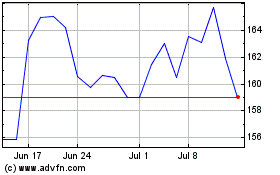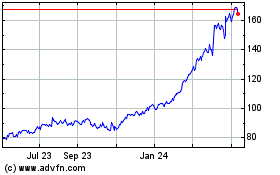As company slims down, its board is expected to firm up plans
for major division
By William Boston
This article is being republished as part of our daily
reproduction of WSJ.com articles that also appeared in the U.S.
print edition of The Wall Street Journal (November 29, 2017).
BERLIN -- Siemens AG, the German engineering conglomerate, is
readying the most significant step yet in its yearslong
restructuring: the listing of a big chunk of its health-care
business, estimated to be worth up to $47 billion.
The company's board is expected Wednesday to hammer out more
details for its plan -- first disclosed last year -- to float a
minority stake in the unit, which makes medical equipment and
provides services for hospitals and diagnostics laboratories. It
competes with similar, large units at General Electric Co. and
Koninklijke Philips NV of the Netherlands.
A decision on where to list the health division could come as
soon as Wednesday. The company is leaning toward Frankfurt after
initially favoring New York, according to people familiar with the
matter.
Siemens isn't likely to set the exact size of the IPO yet but is
targeting listing a slice of between 15% and 25%, according to one
of these people. The company has said it wants to launch the
offering by the middle of next year.
Such a partial listing could be worth anywhere between $6
billion and $12 billion, according to analysts' estimates, and
would rank as one of Europe's biggest IPOs in years. It also would
create a health-care giant that Siemens hopes will be able to
more-nimbly navigate a major shift taking shape in medicine.
Hospitals and health-care providers are moving from their
current heavy reliance on diagnostic tools like X-rays, CT scans
and MRIs to a health-care system that leans more on digital
imaging, genetics, apps and artificial intelligence for both
diagnosis and treatment.
Few believe computers will replace doctors anytime soon, but
they already can scan millions of images in seconds to help them
identify specific illnesses and rule out others. Meanwhile, robots
are increasingly playing a supporting role in surgery.
The IPO of the health-care business, now called Healthineers, is
Chief Executive Joe Kaeser's first step in trying to expand the
business over the next few years -- in part by strengthening its
foothold in imaging equipment and investing in new areas that
promise growth such as molecular diagnostics.
Siemens' health-care business has built a lead in the sort of
high-end hardware that fill hospitals' imaging wings. More
recently, it has pushed into smaller imaging systems that can be
used during surgery or noninvasive treatment to provide doctors
with additional information that was previously unavailable.
When the company outlined its health-care strategy in August,
Michael Sen, a board member overseeing the Healthineers IPO, said
Siemens was taking the division public "because it will give us the
resources that we need for growth and acquisitions."
The health-care business is one of Siemens' most profitable
divisions. In the year ended Sept. 30, Healthineers reported EUR2.5
billion ($2.97 billion) pretax profit on revenue of EUR13.8
billion, a profit margin of 18.1%, up from 17.2% the previous year.
Overall, Healthineers accounted for 17% of Siemens' revenue and 30%
of the company's earnings.
Mr. Kaeser has been trying to rein in the sprawling conglomerate
since he took charge of the company four years ago, shedding
underperforming units such as telecommunications and household
appliances and focusing on a narrower field of more-profitable
businesses.
Those steps accelerated broader efforts begun in the 1990s to
modernize and streamline Siemens' portfolio. For years, the company
was effectively Europe's answer to GE, making power plants,
electricity grids, washing machines, lightbulbs, telecommunications
networks, mobile phones, personal computers and trains. The two
companies have competed fiercely for decades in a number of fields
including power generation equipment and health care.
While Siemens had long been seen as lacking the efficiency of
GE, Mr. Kaeser's restructuring has helped level the playing field
in some investors' eyes.
"Siemens has no need to hide," said Christoph Niesel, a
portfolio manager at Union Investment, one of Germany's largest
investment funds and a Siemens shareholder.
Since Mr. Kaeser took control in July 2013, Siemens shares have
underperformed the DAX index of German blue chips. However, Siemens
shares have delivered total return in dollar terms of 53%, compared
with -10% for GE, says Mr. Niesel.
GE wasn't immediately available to comment.
Mr. Kaeser has made several acquisitions including the gas
turbine and compressor business of Rolls-Royce Holdings PLC and
Dresser-Rand, the U.S. turbine maker. The $7.6 billion purchase of
Dresser-Rand now looks poorly timed. Earlier this month, Siemens
said it would cut 6,900 jobs in its power and gas division amid
falling demand.
But he has sold off far more assets, including a major stake in
its railway business to Alstom SA, its stake in telecoms equipment
maker Nokia Siemens Networks, and its share of a joint venture with
auto supplier Valeo. Siemens also listed its Osram lighting group
in 2013.
--Olaf Ridder in Frankfurt contributed to this article.
Write to William Boston at william.boston@wsj.com
(END) Dow Jones Newswires
November 29, 2017 02:47 ET (07:47 GMT)
Copyright (c) 2017 Dow Jones & Company, Inc.
GE Aerospace (NYSE:GE)
Historical Stock Chart
From Mar 2024 to Apr 2024

GE Aerospace (NYSE:GE)
Historical Stock Chart
From Apr 2023 to Apr 2024
